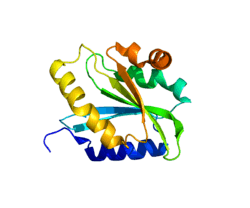TWF2
Twinfilin-2 is a protein that in humans is encoded by the TWF2 gene.[5][6][7]
The protein encoded by this gene was identified by its interaction with the catalytic domain of protein kinase C-zeta. The encoded protein contains an actin-binding site and an ATP-binding site. It is most closely related to twinfilin (PTK9), a conserved actin monomer-binding protein.[7]
References
- 1 2 3 GRCh38: Ensembl release 89: ENSG00000247596 - Ensembl, May 2017
- 1 2 3 GRCm38: Ensembl release 89: ENSMUSG00000023277 - Ensembl, May 2017
- ↑ "Human PubMed Reference:".
- ↑ "Mouse PubMed Reference:".
- ↑ Rohwer A, Kittstein W, Marks F, Gschwendt M (Aug 1999). "Cloning, expression and characterization of an A6-related protein". Eur J Biochem. 263 (2): 518–25. doi:10.1046/j.1432-1327.1999.00537.x. PMID 10406962.
- ↑ Vartiainen MK, Sarkkinen EM, Matilainen T, Salminen M, Lappalainen P (Sep 2003). "Mammals have two twinfilin isoforms whose subcellular localizations and tissue distributions are differentially regulated". J Biol Chem. 278 (36): 34347–55. doi:10.1074/jbc.M303642200. PMID 12807912.
- 1 2 "Entrez Gene: TWF2 twinfilin, actin-binding protein, homolog 2 (Drosophila)".
Further reading
- Yamada S, Uchimura E, Ueda T, et al. (2007). "Identification of twinfilin-2 as a factor involved in neurite outgrowth by RNAi-based screen". Biochem. Biophys. Res. Commun. 363 (4): 926–30. doi:10.1016/j.bbrc.2007.09.069. PMID 17910947.
- Ewing RM, Chu P, Elisma F, et al. (2007). "Large-scale mapping of human protein-protein interactions by mass spectrometry". Mol. Syst. Biol. 3 (1): 89. doi:10.1038/msb4100134. PMC 1847948. PMID 17353931.
- Rush J, Moritz A, Lee KA, et al. (2005). "Immunoaffinity profiling of tyrosine phosphorylation in cancer cells". Nat. Biotechnol. 23 (1): 94–101. doi:10.1038/nbt1046. PMID 15592455.
- Gerhard DS, Wagner L, Feingold EA, et al. (2004). "The status, quality, and expansion of the NIH full-length cDNA project: the Mammalian Gene Collection (MGC)". Genome Res. 14 (10B): 2121–7. doi:10.1101/gr.2596504. PMC 528928. PMID 15489334.
- Strausberg RL, Feingold EA, Grouse LH, et al. (2003). "Generation and initial analysis of more than 15,000 full-length human and mouse cDNA sequences". Proc. Natl. Acad. Sci. U.S.A. 99 (26): 16899–903. doi:10.1073/pnas.242603899. PMC 139241. PMID 12477932.
- Wiemann S, Weil B, Wellenreuther R, et al. (2001). "Toward a catalog of human genes and proteins: sequencing and analysis of 500 novel complete protein coding human cDNAs". Genome Res. 11 (3): 422–35. doi:10.1101/gr.GR1547R. PMC 311072. PMID 11230166.
This article is issued from
Wikipedia.
The text is licensed under Creative Commons - Attribution - Sharealike.
Additional terms may apply for the media files.




